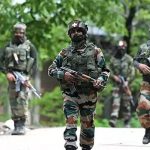This article originally appeared at: https://www.eurasiareview.com/21072025-26-years-since-kargil-how-a-crisis-fueled-indias-comprehensive-military-transformation-analysis/#google_vignette
Twenty-six years ago, in the rugged mountains of Ladakh’s Kargil district, India faced a grave crisis. Pakistani forces, disguised as irregular combatants, covertly crossed the Line of Control (LoC), infiltrating Indian positions vacated due to harsh winter conditions.
This blatant betrayal not only violated international law but also shattered the mutual trust painstakingly built through diplomatic efforts. The Kargil War of 1999—code-named Operation Vijay by the Army and Operation Safed Sagar by the Air Force—ended in a decisive Indian victory, but not without exposing glaring gaps in India’s military preparedness, intelligence coordination, and strategic response capabilities.
In the years since, the Indian Armed Forces have embarked on extensive reforms, overhauling intelligence structures, improving tri-service integration, refining tactical doctrines, modernising equipment, and strengthening infrastructure and logistics. These reforms, driven by lessons from Kargil, reflect India’s unwavering resolve never to be caught off guard again.
Intelligence Reforms: Strengthening the First Line of Defence
The Kargil conflict starkly highlighted the weaknesses in India’s intelligence gathering and coordination mechanisms. The intrusions remained undetected for months, underscoring severe shortcomings in surveillance and inter-agency cooperation. Recognising the critical need for reform, India established the Kargil Review Committee (KRC), which advocated comprehensive changes in intelligence structures.
This led to the creation of dedicated intelligence entities, such as the National Technical Research Organisation (NTRO) and the Defence Intelligence Agency (DIA), which significantly enhanced India’s technical surveillance and intelligence integration capabilities. Now, UAVs, advanced satellite systems, and thermal imagers form a seamless surveillance grid along sensitive areas, notably the LoC. Civilian and military intelligence agencies coordinate far more effectively, rapidly sharing data and actionable intelligence, drastically reducing the likelihood of future infiltrations.
Jointmanship: Building Tri-Service Synergy
The conflict revealed stark deficiencies in joint operations among India’s Army, Navy, and Air Force. Initial delays in coordinating air strikes to support ground forces highlighted an urgent need for deeper integration. To rectify these shortcomings, India introduced the Integrated Defence Staff (IDS) immediately after the war, aligning procurement, logistics, and strategy.
The most significant development came in 2019 with the appointment of India’s first Chief of Defence Staff (CDS). The CDS oversees joint planning, promotes interoperability, and drives the ongoing shift towards integrated theatre commands—unified tri-service structures designed for rapid, cohesive responses to threats in strategically sensitive regions such as the Himalayas and the Indian Ocean. This integration notably improved India’s strategic effectiveness, as demonstrated during Operation Sindoor, launched in response to the Pahalgam terror attack, where coordinated operations underscored the strategic foresight gained from Kargil-era reforms.
Ground-Level Reforms: New Doctrines and Tactical Innovations
The mountainous, high-altitude warfare in Kargil underscored the need for specialised training and equipment. In response, the Indian Army intensified training at the High Altitude Warfare School (HAWS) in Gulmarg, imparting expertise in glacier warfare, survival techniques, and extreme-cold combat scenarios.
The Kargil conflict also accelerated equipment modernisation. Infantry units are now equipped with advanced assault rifles, enhanced body armour, and night-vision goggles, significantly improving soldier survivability. Artillery regiments inducted advanced M777 Ultra-Light Howitzers and K9 Vajra self-propelled artillery systems, ensuring mobility and superior firepower in mountainous terrain.
Similarly, the Indian Air Force (IAF) has significantly upgraded its operational capability since Operation Safed Sagar. The Mirage-2000 aircraft, instrumental during the Kargil conflict, has been modernised with precision-strike and all-weather capabilities. The induction of advanced Rafale fighters and Russian S-400 air-defence missile systems further bolstered India’s strategic deterrent capabilities.
The war notably highlighted limitations in helicopter operations at high altitudes, driving India to develop the indigenous Light Combat Helicopter (LCH—a helicopter designed specifically by India for combat missions in mountainous terrain). Specifically designed for operations at extreme altitudes, the LCH has dramatically improved close-air-support capabilities, critical for swift, effective mountain warfare.
Infrastructure and Logistics: Strengthening Border Resilience
Recognising the strategic importance of logistics and infrastructure revealed by Kargil, India has substantially enhanced its border infrastructure. The Border Roads Organisation (BRO) expedited critical projects such as the Darbuk-Shyok-Daulat Beg Oldi (DSDBO) Road, enhancing troop mobilisation and logistical support capabilities in remote border regions. Improved road networks, fortified bridges, and upgraded airstrips now facilitate rapid deployment, significantly boosting military preparedness.
Satellite surveillance, real-time intelligence feeds, and sensor-based networks have drastically reduced reaction times, enabling proactive responses to border intrusions or threats.
Doctrinal Shifts: Embracing Strategic Proactivity
Strategically, Kargil compelled India to shift from reactive to proactive doctrines. Concepts such as the Cold Start Doctrine, though officially undeclared, indicate India’s preparedness to swiftly respond to provocations with rapid, calibrated offensive operations. This doctrinal evolution enhances India’s conventional deterrence capabilities, especially in a region overshadowed by nuclear considerations.
The Kargil conflict was the first direct military confrontation post the nuclear tests conducted by both India and Pakistan, highlighting complexities in managing conventional conflicts under nuclear deterrence. This has significantly informed India’s strategic posture, doctrine development, and diplomatic initiatives.
Self-Reliance in Defence: Accelerating Indigenous Capabilities
Increased emphasis on self-reliance followed the Kargil conflict. The Defence Research and Development Organisation (DRDO) expedited indigenous defence programmes, and initiatives like ‘Make in India’ have significantly reduced India’s reliance on foreign defence suppliers. From advanced missile systems to indigenous radar and UAV technologies, India’s indigenous defence capability today stands robust, significantly enhancing its strategic autonomy.
A Legacy of Resolve and Reform
Today, 26 years later, Kargil’s most significant legacy is not only the memory of sacrifice but the enduring transformation of India’s military—sharpened, modernized, and strategically proactive in response to past weaknesses. The main argument is clear: Kargil catalyzed India’s ongoing quest for military excellence and readiness for any future challenge.
The betrayal of trust inherent in Pakistan’s covert aggression underscores India’s need for continued vigilance, preparedness, and strategic clarity. The comprehensive military reforms enacted in the wake of the Kargil conflict clearly demonstrate India’s resolve never to allow its sovereignty and security to be compromised again.
India’s victory in Kargil is a testament to the valour and sacrifice of its soldiers. More significantly, it has become a powerful catalyst driving ongoing improvements, strategic foresight, and readiness, reaffirming India’s unwavering commitment to safeguarding its national integrity.













